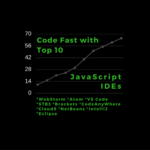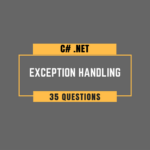This post features the ten best Java IDEs for web development. It highlights their essential features so that you can select the right Java IDE for your projects.
Java is the most popular programming language for the Web and is used by a large percentage of Fortune 500 companies like Alphabet (formerly Google), Accenture, Intel, Target, and so on. However, creating Java applications is not as easy as cutting a piece of cake.
Being a Java developer, you might have wondered how to create the best Java applications which are fast, robust, and reliable. However, let us tell you that it would take more than just a great developer with excellent programming skills. Hence, you need the right tools to deliver work on time and with the desired quality.
10 Java IDE – Find out the Best

1. NetBeans – The Best Java IDE Sponsored by Oracle [Freeware]
NetBeans is a popular IDE for web development. It is an IDE created by developers for developers to make coding as easy and efficient as possible.
Not only does it support enterprise web applications, but you can also use it to create mobile and desktop apps. And it allows you to reuse your project workspace on multiple platforms like Windows, Linux, Mac OS X, and Solaris from Oracle.
NetBeans addresses most of the challenges a developer might face during the project lifecycle. It will let you manage all tasks starting from analysis, design, coding, debugging, unit testing, code coverage, source code control, and deployment. Moreover, you don’t need any plugins for these features, as all of them are inherent in NetBeans.
Your code might have untracked bugs which are hard to find and can cause delays. But with inbuilt tools like static code analysis, integration of the FindBug plugin can help you identify and fix complex issues in the code. Also, the NetBeans debugger gives you a free hand for stepping through the source, setting break-points, adding watches, taking pictures, and tracking execution.
Moreover, it comes with a powerful code profiler to assist in optimizing your application performance (speed and memory). You can build robust, reliable, and scalable Java and J2EE applications. Next, it also includes a visual debugger for enabling you to debug user interfaces without intervening in the code.
You might not want to miss on Maven, which has got seamless support from NetBeans. Resolving and adding dependencies take just a couple of clicks to complete. It lets you skip the unwanted downloading/rebuilding of indexes.
NetBeans supports all popular Web application frameworks (Spring/Struts/Wicket) and libraries like PrimeFaces, RichFaces, and ICEfaces.
Our Pick: 10 Best IDEs for CPP / C++
2. IntelliJ IDEA – The Best IDE for Java Developers [Paid Java IDE]
IntelliJ IDEA is a slick, fast, and reliable tool for web development in Java. It is none other than the featured tools development company JetBrains, that runs this product and updates it for the growing market needs.
The company delivers it in two forms: The free community version and the Paid ultimate edition. The free version is to encourage students, teachers, and plugin developers, whereas the paid version is for organizations coding commercial applications.
IntelliJ Community Edition
Enables free support for frameworks like Android, Swing, and JavaFX. It is also versatile in supporting programming languages like Java, Groovy, Kotlin, Scala, Go, Dart, Erlang, and Python.
Also, the IDE is lightweight. It brings a few other features like JUnit/TestNG test runners, debugging, code completion, code inspections, code refactoring, maven wizard, Ant, and a visual GUI builder.
IntelliJ Ultimate Edition
It’s a premium IDE that supports many leading programming and scripting languages, e.g., JavaScript, TypeScript, SQL, CSS, LESS, Sass, Stylus, CoffeeScript, ActionScript, Ruby, and PHP.
For world-class web development, you need the Ultimate version as it integrates frameworks like Spring MVC, J2EE (JSF/JAX-RS/CDI/JPA), Grails, Griffin, React, Angular JS, Node.js, Django, Flask, CMS (Drupal/WordPress/Laravel).
3. Eclipse – The Illustrious IDE for Java Developers [Freeware]
Eclipse is a new-age, cross-platform, open-source, and freely distributed IDE available for enterprise web development. It was IBM Software Group in 1998 that conceived of an IDE that could penetrate deep into the competitive IDE space and be a leader. That’s what makes Eclipse one of the best Java IDEs for web development.
Interestingly, Eclipse is itself an example of the best Java application, as it’s mostly written in Java. It was always meant to be a robust, full-featured, commercial-quality platform for developing modern web applications.
Eclipse has the following essential features to become an ideal Java IDE.
- Java 8.0 and 9.0 support
- Code refactoring, code editing with prompt validation, incremental compilation, cross-referencing, and code suggestions.
- Integrated static code analysis
- Intelligent code completion and quick fix
- Excellent usability and performance
- Support for Win/Linux/Mac OS X
- Shows a default template for placing +ve/-ve null checks.
- Helps you classify a security level for specific errors in the code.
- Detects and removes redundant type arguments.
- Allows annotation-based null analysis to use multiple sets of annotation types.
- Accepts additional debug arguments, and the OS resources view allows attaching a process for debugging.
You can see that there are plenty of time-saving features in Eclipse. You can even create custom code templates to boost your coding speed.
Also Read: 10 Best IDEs for Python
4. Android Studio – A Java IDE Tailored for Android Developers
Android Studio is a modern IDE for out-of-the-box Java and Android application development. It is relatively a new product which got released in the mid of 2013. Derived from IntelliJ IDEA, Android Studio delivers the optimum turnaround on your design and code workflow.
Android Studio bundles a whole list of features that include intelligent code editing, debugging, unit testing, and code profiling. Let us look at each of them in a little more detail.
- Instant update and run make your code changes pushed immediately to the running app. It doesn’t require restarting of application.
- An inbuilt and lightweight emulator installs and runs your apps within no time. It makes your app run on a variety of device configurations.
- The next-generation code editor provides a platform to write quality code, reduce time, and increase productivity. You get help from using advanced code completion, refactoring, and code inspection.
- The excellent build system (Gradle) helps in automating build, formulating dependencies, and preparing custom build configurations.
- Gradle is a multi-device build system. It works the same for all Android devices, be it a tablet, a mobile phone, or an Android TV.
- Easy integration with version control systems, e.g., GitHub and SVN
- It is also possible to prepare the Build environment for execution on a CI server like Jenkins and Bamboo.
- Readymade code templates can make app development easy and fast.
- Test your app with JUnit 4 and regress the UI using Espresso Test Recorder.
- Keep track of coding defects by running the inbuilt static code analysis tool at regular intervals.
- Make the most of the built-in tools like Layout Editor, Vector Asset Studio, APK Analyzer, and Translations Editor.
In short, Android Studio is one of the best Java IDEs, which you must try for both desktop and mobile app development.
5. JDeveloper – A Free IDE to Simplify Java Application Development
JDeveloper is a powerful Java IDE that is open source and initiated by Oracle. It supports the complete end-to-end development and addresses all phases of the application lifecycle.
It offers an advanced code editor, which increases the developer’s productivity with features such as code auditing, integrated unit testing, and code profiling. Apart from Java, you can utilize its visual editors for programming in languages like SQL, XML, PHP, JavaScript, HTML, and CSS.
This IDE is optimized for managing J2EE applications, and databases, implementing REST/SOAP web services, and mobile apps, and supporting Oracle Fusion Middleware components and applications.
Also, it embeds a couple of tools to speed up the development process. One of them is the integrated WebLogic Server, which lets you run, test, and debug your J2EE applications. Others include SQL browser and PL/SQL editor to assist in building queries, browsing databases, and generating reports. Another stone in the wall is the WSDL editor, which expedites SOAP and REST service development.
Also, two more tools to watch for are the inbuilt XSD/XML schema generators and service test runners.
Must Read: Top 10 IDEs for R Programming
6. DrJava – A Lightweight Development Environment for Java Programs
DrJava is a light and responsive development environment for writing Java programs. Initially, its purpose was to acquaint beginners with Java via interactive learning. However, later, a no. of extra features were added to serve the advanced users.
DrJava is one of those IDEs which started to support test-driven development. It bundles features like an intelligent code editor, an interactive terminal for evaluating program output, a source code debugger, and a unit test runner.
In addition to the above features, it supports Java 8 and newer versions. Another useful addition is the integration with the Jacoco tool for code coverage. When you run the unit tests, it’ll generate reports containing links reporting the code coverage.
So, in our opinion, DrJava is best suited for users who recently started learning Java. They can build Java programming skills and then transition to a more business-oriented tool like NetBeans, Eclipse, or IntelliJ.
7. JEdit – A Matured Code Editor for Java Developers
JEdit is an intuitive code editor used by many Java programmers over the years. It supports all leading platforms like Mac OS X, OS/2, Unix, VMS, and Windows.
Like Eclipse, Java is the programming language used to develop JEdit. It is also one of the best Java applications freely available for use under GPL 2.0.
Though, this IDE has a small footprint but offers some of the cutting edge features.
- Being developed in Java, JEdit enjoys the interoperable capability as Java does.
- It includes an inbuilt Macro language to automate any repetitive task. You can also make use of available Macros.
- JEdit packs with an interactive Plugin manager to search and download the plugins you like.
- Its code editor supports word wrap, code folding toggles, auto-indent, and syntax styling for 200+ languages.
We believe a programmer should keep looking for ways to turn the wheel. Then only he can bring change and support innovation. So he should keep exploring new tools and technologies.
Check Out: 10 Best IDEs for GoLang
8. MyEclipse – The Full Stack Java IDE for Web Development
MyEclipse is one of the productivity tools to make the development process more efficient. Behind MyEclipse is a Texas-based company called Genuitec, which built it on top of open-source Eclipse.
It supports all three sides of the end to end product development, which are Enterprise Development, Web Development, and Full Stack Development.
Let’s now have a quick view of the features it provides.
- Enhanced J2EE support for all notable frameworks like Spring, JPA, JSF, Jquery, and Cordova
- Intelligent code editing with content assist, instant validation, syntax highlighting, navigational help (breadcrumb toolbar and minimap view)
- Complete maven project lifecycle management
- Integrated MySQL, SQL Server, and Sybase support
- Brought in Spring scaffolding to auto-generate a turnkey Spring project
- Inbuilt WebSphere to run, test, and debug your application on the fly
- Other application servers like WebLogic, Apache Tomcat, GlassFish, and Derby have out-of-the-box support
- Allow creating dynamic web apps using TypeScript and Angular 2 (ES6)
- Finer support for restful web service development and testing
- Get a live preview of your code with an integrated CodeLive tool
- Cross-browser testing and mobile simulator support
- Share and discuss coding updates using an integrated Slack
So you’ve now seen that MyEclipse is full of features that can improve the productivity of any Java developer. This tool is worth trying if you want to do serious web development in Java.
9. JCreator – A Slick IDE for Development in Java
JCreator is also one of the best Java IDEs that provides interactive development experience to Java developers. It lends you more firepower than any other code editor for Java.
Xinox Software is the IT company propelling JCreator development. The IDE has two variants, the Lite version with limited features and the Pro edition with the full set of features.
- Easy Project Management Interface similar to Visual Studio
- Custom color scheme to organize code
- Configure multiple JDK profiles and use them in projects
- Choose the project template of your choice for a quick start
- Support for build and version control tools like Ant and CVS
- Automatic evaluation of classpath, custom user interface
- Ability to run your application as an applet, with JUnit, or in a terminal
- Built-in tools to call external functions and utilities, e.g., XML validation, Java code formatting, RMI compiler, etc.
This IDE gives due attention to ease of use, speed, performance, and great user experience. It takes inspiration from Microsoft Visual Studio. If the users have prior experience with VS, then it would be easier for them to migrate.
Recommended: 10 IDEs for JavaScript Programming
10. GreenFoot – The Online Java Instructor and IDE
GreenFoot is a specialized graphical code editor mainly focusing on Java training for newbies via interactive teaching. It formulates an environment to generate simulations for GUI programs and games written in Java.
The IDE has documented every functionality in detail and made it available for both beginners and advanced users. It helps all of them in ramping up quickly. The IDE has a simple and straightforward user interface and comprises a single window to model all objects and classes of an application.
GreenFoot has all students, teachers, and trainers as the target audience. However, it comprises all the required features for a broad range of Java developers.
- The IDE teaches object-oriented concepts via object modeling. It works on the idea of creating actors that live in worlds to build simulations, GUI programs, and games.
- The GUI editor allows adding classes with just a click. However, you can add more depending on your use case.
- It is also easy to extend a class or inherit subclasses from the base class. And that too, you can do with the visual editor.
- GreenFoot has extensive support for image libraries grouped into categories like animals, objects, buildings, people, and symbols. You can even use the examples to learn and start building a solid knowledge base.
- The IDE features project management, code assist, auto-completion, syntax highlighting, and other relevant tools.
With such interactive features, there are a large no. of institutions inclined to use GreenFoot. It has made Java learning easy enough for beginners to write robust, reliable, and scalable Java applications.
Conclusion
Finding the best Java IDE in such a crowded space is like discovering a pearl in the ocean. However, we have shortlisted the list of 10 best Java IDEs after in-depth analysis and described their unique selling points.
We hope that the above review will assist you in choosing the right tool for development.
Thanks,
TechBeamers








